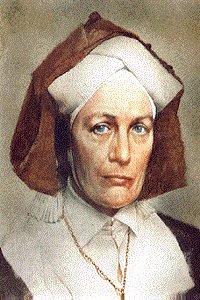
Hildegard Von Bingen
The role of women in the Middle Ages was defined by their position both in society and within the structure of their own family. Women of the peasant classes were expected to perform the majority of the chores for their own families, as well as for their overlord. Women of wealth were free to pursue leisurely pursuits such as stitchery, devotion to religion, or gossip. When Hildegard von Bingen was born, she was the tenth and final child of her parents' union. Since her parents were of the noble class, Hildegard was promised to the church for service. This show of devotion to the church was no only expected of her parents, but a wise move as well. Finding a suitable husband for their many daughters was proving very difficult, so one more daughter to marry off was a great burden. The church, in Hildegard's case, assumed the role of husband upon the time she entered into a nunnery under the direction of the recluse, Jutta, at the age of fifteen until her death at age 81 in the year 1I79. Even before her official entry into the service of the church, Hildegard seemed to have an understanding of religious devotion and was gifted with visions of a decidedly religious nature. Although she was never officially canonized as a saint, she was given a feast day, September 17th. During the 1200's and 1300's several popes attempted to have her canonized, but she did not meet the stringent guidelines that identified a true saint. Eleven years after she took the veil, Hildegard became mother superior of the nunnery she had entered. For nearly twenty years, she concentrated solely on the operation of the nunnery. In 1141, however, she began to write down the many mystical visions that she had experienced throughout her life. The result, entitled Scivias, which contained twenty-six of her revelations, took some ten years to complete. Two more books of her prophetic, apocalyptic and symbolic visions followed in 1158 and 1163. Perhaps as a result of her recorded visions, Hildegard was consulted by the men in such politically powerful positions as pope, emperor, king, and on a more local level, archbishop and bishop. Beginning in 1147, she established a monastery in Rupertsburg, a small village on the Rhine River near Bingen. It is here that she lived out her days, writing down her visions, composing lyrical poetry and the first surviving morality play, and writing treatises exploring medical and scientific learning of her time. First and foremost in each of her works, she considered her relationship to God. Hildegard's lyrical poetry is written in language that belies its creator's mysticism. Indeed, the title she gave to a collection of her poetry (dating from the 1150's) is Symphonia armonie celestium revelationum, or Lyrical Poetry of Celestial Revelations. The collection comprises some 77 poems, all of which are set to music. All of the poems can be used liturgically, for they include hymns, sequences, an alleluia, antiphons, and a Kyrie. The poems form a liturgical cycle, and are meant either for specific feasts (such as a local saint's commemoration day) or for broad classes of feasts (as in days commemorating Holy Women). The language is vividly imaginative in its symbolism and reflective of her apocalyptic and prophetic visions. Perhaps the most revealing work by Hildegard is her morality play, Ordo Virtutum, the earliest surviving drama of its type. The plot of the play deals with the struggle between the devil (Diabolus) and the sixteen Virtues for the soul (Anima). As she set her words to music, Hildegard showed her dramatic sense: the Virtues and Anima are all given very syllabic, pleasing, chant-like melodies, but Diabolus is required to shout his lines unmusically. Hildegard's chant melodies, which are not a part of the body of so-called "Gregorian" chant, are very individualistic for the times during which they were written. Although her approach to text setting is typical of the time, she uses a number of melodic formulas--short melodic patterns--that recur either exactly or somewhat varied. They are assembled and reassembled like a patchwork quilt. This process, known as centonization, was practiced by earlier cultures in their indigenous musics.






